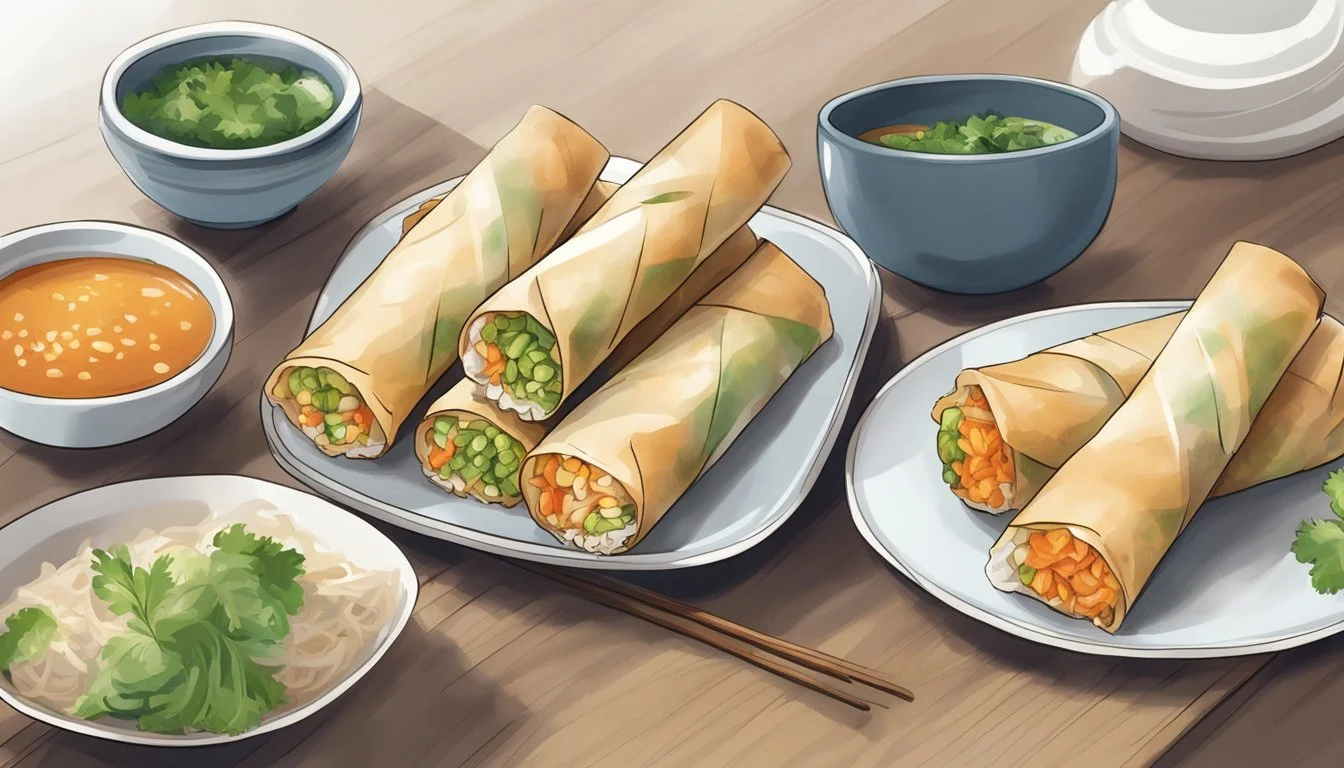How Long Do Gluten-Free Spring Rolls Last?
Storage Tips and Shelf Life
Gluten-free spring rolls are a delightful option for those adhering to a gluten-free diet, featuring fresh ingredients encased in delicate rice paper wrappers. These rolls combine wholesome herbs and savory fillings to create a snack or side dish that is both nutritious and satisfying. When it comes to preserving the freshness of these gluten-free delights, storage practices play a crucial role.
Gluten-free spring rolls, when stored properly in the refrigerator, can last for up to 24 hours. To maintain their texture and taste, each roll should be individually wrapped in plastic and covered with a damp paper towel before being placed in an airtight container. The fridge temperature should be kept below 40°F (4°C) to ensure optimal freshness.
Whether preparing these spring rolls for a special occasion or a quick meal, understanding their shelf life ensures they remain as fresh and tasty as the moment they were made. By following these storage tips, you can enjoy the delightful flavors of gluten-free spring rolls without any compromise on quality.
Understanding Gluten-Free Spring Rolls
Gluten-free spring rolls feature unique components and encompass various varieties each suited to different culinary preferences. They are versatile and can be tailored to specific dietary needs by changing the wrappers or fillings.
Components of a Gluten-Free Spring Roll
Gluten-free spring rolls typically use rice paper wrappers instead of the traditional wheat-based ones. These rice paper wrappers are soaked in warm water until they become pliable and ready to wrap around the filling.
The fillings can vary widely but often include proteins such as tofu, shrimp, or chicken. For a vegan option, tofu is commonly used, providing a protein-rich alternative.
Vegetables are a staple in gluten-free spring rolls, with popular choices including shredded carrots, cucumbers, and bell peppers. Fresh herbs like mint, basil, and cilantro are also common, adding vibrant flavors and fragrances.
Some recipes also incorporate rice noodles or bean sprouts to add texture and substance. A light seasoning or sauce, often incorporating flavors such as soy sauce (gluten-free), rice vinegar, and chili, completes the filling.
Differences Between Spring Roll Varieties
Spring rolls can be differentiated by their region and cooking method. For instance, Vietnamese spring rolls or summer rolls are typically fresh, not cooked, and emphasize the natural taste of the ingredients.
In contrast, Chinese spring rolls may be fried, with a crispy exterior that contrasts with the soft, flavorful filling. These can be either vegetarian or include meats like pork or shrimp.
Thai spring rolls often have a richer flavor profile due to the addition of ingredients like shrimp, crab, and a variety of seasonings.
Egg rolls, a popular variation, have thicker wrappers made from wheat—not suitable for gluten-free diets—and are usually fried.
While fried spring rolls are common, baked spring rolls offer a healthier alternative, avoiding the oil used in frying. Regardless of the variety, each type of spring roll has its own unique combination of wrappers and fillings, making them a versatile option for different dietary preferences.
Preparing Gluten-Free Spring Rolls
Crafting gluten-free spring rolls involves careful ingredient selection and following specific recipes to ensure they cater to a gluten-free diet. It is essential to use gluten-free wrappers and fresh fillings, combined with appropriate sauces for the best taste and texture.
Selecting the Right Ingredients
When preparing gluten-free spring rolls, the wrappers are of primary importance. Rice paper and tapioca flour wrappers are popular gluten-free options. These have a translucent appearance and create a light, crispy texture when fried or baked.
Fresh vegetables like carrots, cucumbers, bell peppers, and lettuce provide a crunchy texture and vibrant flavors. Adding thinly sliced protein such as pork belly or shrimp can enhance both the taste and nutritional value.
It's also beneficial to use gluten-free soy sauce and seasoned rice vinegar for added flavor without compromising dietary restrictions. Preparing all these ingredients in advance is key to assembling the rolls quickly and effortlessly.
Gluten-Free Spring Roll Recipes
For a simple yet delicious recipe, use rice paper. Dip each sheet in warm water, place it on a towel briefly to remove excess moisture, and then lay it on a plate. Arrange the prepared vegetables and protein in the center.
Roll tightly, folding edges as you go to create a neat package. Brush a touch of egg yolk on the loose end to seal. Preheat your fryer to 175°C (350°F) for a perfect fry.
Alternatively, homemade spring rolls can be customized with dipping sauces like peanut sauce. Thinly slice your favorite vegetables and add a protein of choice. Consume immediately or store them covered with a damp paper towel to prevent drying out.
Cooking methods may vary, but proper care and fresh ingredients ensure delightful gluten-free spring rolls every time.
Shelf Life and Storage
Gluten-free spring rolls have limited shelf life, impacted by storage conditions and whether they are fresh or cooked. Proper storage methods can extend their freshness and prevent spoilage.
Storing Fresh and Cooked Spring Rolls
Fresh gluten-free spring rolls typically last 1-2 hours at room temperature. To prevent rapid deterioration, they should be refrigerated if not consumed immediately. When refrigerating, wrap each roll in parchment paper and place them in an air-tight container.
Cooked gluten-free spring rolls have a similar shelf life but can be refrigerated for up to 3 days. For leftovers, store them in a container lined with parchment paper to absorb excess moisture, ensuring they don’t become soggy.
For longer storage, spring rolls can be frozen. Place them in a single layer on a baking sheet to freeze individually before transferring them to a sealed freezer bag. This method maintains quality up to 2 months.
Identifying Spoilage
To identify spoilage in gluten-free spring rolls, check for changes in smell, texture, and appearance. Signs of spoilage include off odors, slimy textures, or visible mold. Fresh rolls may also show discoloration.
In the refrigerator, monitor for drying out; if the wrappers become brittle or crack, they are no longer good to eat. While frozen rolls show less spoilage, ice crystals or freezer burn may indicate compromised quality.
Following these guidelines ensures a longer shelf life for your gluten-free spring rolls while maintaining their taste and safety.
Nutrition and Dietary Considerations
Gluten-free spring rolls are a nutritious and accommodating option for various dietary needs. They can provide specific health benefits and have a mindful caloric and macronutrient profile important for several dietary restrictions.
Health Benefits of Gluten-Free Diet
For individuals with celiac disease or gluten intolerance, gluten-free spring rolls are a safe option. These rolls can lessen symptoms like bloating, diarrhea, and abdominal pain, which are often triggered by gluten.
Digestive health can see improvements as gluten-free diets tend to include more fiber-rich foods. The use of fresh vegetables, herbs, and rice paper in the rolls supports this benefit.
A gluten-free diet can also promote overall well-being by encouraging the consumption of whole, unprocessed foods. This can lead to better blood sugar levels and reduced inflammation.
Caloric Content and Macronutrient Profile
Gluten-free spring rolls are generally low in calories, making them a healthy snack. For instance, a typical vegetable spring roll can contain around 50-100 calories, depending on the ingredients.
These spring rolls have a low-fat content, especially when not deep-fried. They typically contain about 1-2 grams of fat per roll, mostly from healthy sources like avocado or sesame seeds.
Protein content in vegetable-based spring rolls is moderate, around 2-4 grams per roll. Adding protein-rich fillings like tofu or shrimp can increase this amount, making the rolls a more satisfying choice from a macronutrient perspective.
In conclusion, gluten-free spring rolls cater to various dietary requirements while providing essential nutrients in a balanced form.
Cross-Contamination and Safety
Ensuring gluten-free spring rolls remain safe for consumption involves addressing potential cross-contamination and adhering to careful preparation methods. This is crucial for those with celiac disease or gluten intolerance.
Preventing Gluten Cross-Contamination
Preventing cross-contamination starts with a clean and separate preparation space. Food surfaces should be thoroughly cleaned to avoid any gluten traces. Utensils and cooking tools must also be gluten-free specific or cleaned meticulously before use.
Ingredients should always be checked for hidden gluten. Labels must state that items are certified gluten-free. Items like gluten-free tamari should be chosen over regular soy sauce, which often contains gluten.
Communication is key in commercial kitchens. Informing chefs and servers about gluten intolerance requirements ensures extra caution is taken. Setting aside initial slices when using shared equipment, such as deli slicers, helps remove residual gluten.
Implementing these strategies reduces the risk of gluten exposure, making gluten-free spring rolls safer to eat for those with celiac disease or gluten intolerance.
Serving and Presentation Tips
When serving gluten-free spring rolls, the right pairings and presentation can greatly enhance the dining experience. In particular, selecting the ideal dipping sauces and employing thoughtful plating techniques can make a big difference.
Pairing with Dips and Sauces
Select dipping sauces that complement the flavors of gluten-free spring rolls. Peanut sauce, often prepared with peanut butter, soy sauce, and lime juice, is a popular choice. For those avoiding gluten, tamari soy sauce is a safe substitute.
Another option is a simple chili lime sauce made with fresh lime juice, sesame oil, and garlic powder. This tangy and spicy dip pairs well with both traditional and spicy noodle spring rolls.
Consider offering several sauces to cater to different tastes and dietary preferences. Some favorites include hoisin sauce, sweet chili sauce, and a light vinaigrette with fresh herbs.
Decorative Plating Techniques
Presentation elevates the dining experience, making the appetizer visually appealing. Use vibrant, fresh ingredients like butter lettuce and fresh mint to garnish the plate.
Arrange the spring rolls neatly, perhaps in a circular pattern on a platter. Place dipping sauces in small bowls around or on the side, ensuring they are easily accessible.
Using bright-colored plates can also enhance the presentation. For a restaurant-quality touch, add edible flowers or thinly sliced vegetables like carrots and cucumbers. These not only add color but also texture.
By thinking creatively about how the plate looks, the spring rolls will make a stylish and inviting appetizer.
Culinary Techniques and Alternatives
Cooking gluten-free spring rolls can involve various methods and ingredient substitutions to maintain taste and texture while accommodating dietary restrictions. These techniques include both traditional and alternative approaches.
Cooking Techniques for Spring Rolls
For gluten-free spring rolls, frying is a common method that results in crispy rolls. To achieve this, make sure the oil is hot enough, around 350°F (175°C), to avoid greasy rolls. Use gluten-free wrappers such as rice paper, ensuring they are softened in warm water before wrapping.
Baking is a healthier alternative. Preheat the oven to 400°F (200°C) and brush the rolls with a light coating of oil to promote crispiness. Bake for about 15-20 minutes, turning halfway through.
For an air fryer, preheat to 375°F (190°C) and spray or brush rolls with a little oil. Cook for 8-10 minutes, flipping midway. This method provides a crispy texture with less oil.
Steaming is also an option, especially for those looking to avoid oil. Place rolls in a steamer basket over boiling water for 5-7 minutes. This method results in softer rolls, which may pair well with a robust dipping sauce.
Gluten-Free Alternatives and Substitutions
Rice paper is a popular substitute for traditional wheat-based wrappers. It’s naturally gluten-free and can be softened in warm water before use. Rice paper works well for both fresh and fried spring rolls.
When making fillings, gluten-free soy sauce is essential to replace regular soy sauce, which typically contains wheat. This diminishes the risk of gluten contamination in the dish.
For vegan or dairy-free options, ensure fillings are free of animal products and dairy. Tofu, mushrooms, and a mixture of vegetables make for excellent fillings while maintaining flavor and texture integrity.
Alternative ingredients can include gluten-free flours and starches, like tapioca or potato starch, to achieve the right consistency for homemade wraps. Creativity in ingredient use can maintain the desired taste while adhering to dietary needs.
The Role of Texture and Flavor
The texture and flavor of gluten-free spring rolls are crucial for an enjoyable eating experience. Fresh ingredients, proper balance, and the use of herbs and spices significantly impact these aspects.
Balancing Texture in Spring Rolls
A well-made gluten-free spring roll achieves the ideal balance of crispness and chewiness. Fresh vegetables like carrot and cabbage provide a satisfying crunch. Soft, cooked vermicelli noodles or bean sprouts add a chewy, tender bite that contrasts with the crispy vegetables. The use of rice paper or glass noodles as the wrapping ensures that the spring rolls have a slight give that makes each bite pleasant.
Different ingredients contribute various textures. For example, shredded cabbage offers a crisp texture, while julienned carrots provide a firm yet slightly tender crunch. Including a mix of these textures ensures a more exciting and varied eating experience. Ensuring that the ingredients stay fresh also maintains their texture, keeping the spring rolls from becoming soggy or stale.
Enhancing Flavor with Herbs and Spices
Flavor enhancement in gluten-free spring rolls often relies on fresh herbs and spices. Cilantro, mint, and basil are popular choices that introduce vibrant, aromatic notes. These herbs complement the fresh vegetables and give the spring rolls a bright and refreshing taste.
In addition to herbs, using spices like a touch of chili or a hint of ginger can elevate the flavor profile. Seasonings such as seasoned rice vinegar added to the cooked noodles, or a peanut sauce dip, further enhance the taste, providing depth and complexity. These elements work together to ensure that each bite is packed with flavor, making the gluten-free spring rolls as delightful as their traditional counterparts.
Frequently Used Terms in Gluten-Free Cuisine
Being familiar with key terms is essential for anyone navigating gluten-free cuisine, whether due to celiac disease or gluten intolerance. Understanding these terms can help you make informed food choices and better understand product labels.
Understanding Gluten-Free Terminology
Celiac Disease: An autoimmune disorder where ingestion of gluten leads to damage in the small intestine. People with celiac disease must avoid gluten to prevent severe health issues.
Gluten Intolerance: A condition that results in discomfort or other symptoms when gluten is consumed. Unlike celiac disease, it doesn't cause intestinal damage but still requires gluten-free dietary choices.
Gluten-Free: Indicates that a product contains less than 20 parts per million (ppm) of gluten. This label is crucial for safe consumption by those with celiac disease or gluten intolerance.
Wheat Flour: A common ingredient in many foods that contains gluten. Substitutes like rice flour are often used in gluten-free recipes to mimic the same texture and consistency without the gluten.
Label: Always check the ingredient list on food packaging for hidden sources of gluten. Understanding label terminology is key for safe and informed shopping.










